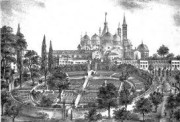Brief City’s History
Bologna has probably been inhabited as early as 900 BC by antique populations as Umbrians and Etruscans who called it “Felsina”. Afterward, around the V century BC, the Gauls came down from northern Europe and ruled until about 196 BC, when they were ousted by Romans who, in 189 BC, gave to “Felsina” the new name of “Bononia” ( Bologna ). After the fall of Roman Empire Bononia came under the control of many different populations: Odoacre ( a Germanic King ), King Teodorico ( barbarian Ostrogota ), the Bizantine Empire, the Lombards and then, in 774 AD, Charlemagne who gave the City to Pope Adrian I°. In the 1115 AD, after Matilde di Canossa’s death, Bononia received from Emperor Enrico V the chance to become a free Municipality. The City expanded and enriched itself through a complex web of ship canals and its population grew, making it one of the most inhabited Cities of the whole Europe. The first University of the World, as it is commonly believed, was born right here in 1088 AD. In the subsequent centuries Bologna was torn by the fights between Guelphs and Ghibellines. In 1256 AD Bologna was the first City in the World to abolish the slavery through the famous ” Law of the Paradise ” which ransomed them paying a market value set for their ransom. From 1337 AD to 1401 Ad the Pepoli family ruled the City in an enlightened way; after them The Bentivoglio family took charge of Bologna until 1507 AD. In that year the City came under the control of the Papal State that ruled it until the Napoleon arrival in 1796 AD. In 1815 AD, after the Congress of Vienna, Bologna went back to the Pope. Subsequently the Austrians arrived in the City and remained until its annexion to the Sardinia’s Reign which then became the Reign of Italy an year later.
The City
Bologna is ubicated in the heart of Emilia Romagna, one of the richest Regions of the whole Italy. Emila Romagna is also the place, according to the famous american magazine Forbes, where there is the best cuisine of the World. Bologna is rich of charming given by its conformation, its monuments, its endless porches, its nearby hills inhabited by the richest families of the City, its thousand restaurants and taverns where eating listening to live music, its world-famous University with so many students who are always strolling around City center. Bologna is quite a big City now, but when you get there you don’t have the feeling of being in a Metropolis; in effect, there is not a Metro, nor skyscrapers…the City center is traversed by thousands of pedestrians, bikes and bus. Inside one of the oldest and biggest City-Centers of Europe there is the incredible number of 38 kilometers of antique porches ( 42 kilometers counting also those outside the center ). In this wonderful City there are many Museums, Libraries, Theatres, Churches, Palaces and old Mansions, the two famous towers and also a famous American University. Therefore in Bologna you will find history, culture, food and an active nightlife with many clubs.
1. San Petronio Cathedral: The late Gothic Cathedral of San Petronio, dedicated to Bologna patron Saint, is the most famous of the City. With its 132 meters in length, 60 in width, and 44.27 in height it is the sixth bigger church in Europe, and the fourth bigger in italy. The building started on June 1380 AD, with the demolition of some Roman insulaes ( condos ) overlooking Piazza Maggiore; then stopped and resumed again and again, under the direction of different architects ( from Antonio di Vincenzo to Arduino degli Arriguzzi, Francesco Morandi Terribilia, Carlo Carrazzi nicknamed the Cremona, Girolamo Rainaldi and Francesco Martini ), and lasted up to 1663 AD, date of the construction site closing. The lower part of the facade is made of white and red marble, while the upper one is brick-made ( probably it also had to be covered with marbles as the lower part ). Its sides are decored with buttresses and huge windows of drilled marble.Inside there are the main, central nave, and four aisles; with big spans of 19 meters, sustained by huge pillars, and twenty two chapels, eleven on the left side and eleven on the right side.
2. Asinelli Tower: at the end of the twelfth century, Bologna had more than a hundred towers, today only twenty of them have survived. The Asinelli Tower is the most important remained at Bologna. The Asinelli Tower, built by the same family between 1109 and 1119 AD, was placed at the entrance of the City near the Via Emilia, to signal the arrival of the enemies. 97.20 meters high, has an open gallery surrounding its square base which hosted the guard duty soldiers. To climb to the top and watch Bologna from above, visitors have to climb 498 steps, in 1791 AD, the scientist Giovanni Battista Guglielmini dropped an object from the top of the tower, to demonstrate the Earth’s rotation.
3. Maggiore Square: the ancient Medieval Piazza, then called Platea Communis (Piazza Maggiore), is one of the largest squares in Italian; with 60 meters x 115 meters. It was built in the thirteenth century and still host the Basilica of the Patron saint of the City and many medieval buildings.
4. Ancient Roman Theatre : the ancient Roman Theatre was built in the late Roman period (120 BC – 80 BC), later expanded during the reign of Augustus and Nero. His chamber, 75 m wide, is self-supporting.
5. San Petronio Basilica: The gothic Basilica of San Petronio, founded on June 7, 1390 AD, and dedicated to the Saint and patron of the City, is the most popular of Bologna. Located in Piazza Maggiore is the sixth largest Church in Europe and the fourth largest in Italy (132 meters long and 60 wide, with a height of 44.27 meters and a of 51 meters on the front). The construction work began with the demolition of several insulae of ancient medieval town that overlooked Piazza Maggiore and ended in 1663 AD. The structure of the Basilica has three aisles supported by ten pillars with polygonal ribs, of which the central one has a square plant and the lateral ones have instead a rectangular plant. Beside the lateral ones there are, in correspondence of each span, two chapels ( them also with a square plant ). Outwardly the facade, with its three doors, is covered on its lower part by white marble while its upper zone is brick made. Internally the Church has a simple and linear gothic style, with 3 aisles and 22 lateral chapels, and a very famous sundial. The projects of the Basilica were many, from that one belonging to Antonio di Vincenzo, to that of Arduino degli Arriguzzi, to those by Francesco Morandi, Carlo Carrazzi and Giacomo Rainaldi and, at the end, to that of Francesco Martini. The Bell Tower is located on the back of the Basilica.
6. San Pietro Cathedral : The very old Cathedral of San Pietro which dates back to IV° century AD , is the major cult place in the whole City. Located on the important Indipendenza avenue, is a Gothic edifice with a Baroque facade. During the centuries it has been destroyed and rebuilt several times, first outside the City center walls then inside them. The Church has three aisles with five chapels on each lateral aisle. The facade is made of red bricks with white marble decorations and the Bell Tower is 70 meters tall. Internally the Church is full of light thanks to its big windows.
7. Bologna National Picture Gallery: the Bologna National Picture Gallery, with its thirty exhibition halls and spaces for educational activities and exhibitions, contains enormously important works of art of Emilia, from the thirteenth to the beginning of the nineteenth century and is one of the most famous Galleries in Italy and abroad.






